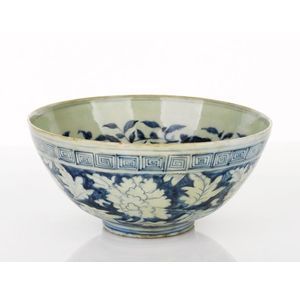Wedgwood Creamware Bowl with Sailing Ships Design
You must be a subscriber, and be logged in to view price and dealer details.
Subscribe Now to view actual auction price for this item
When you subscribe, you have the option of setting the currency in which to display prices to $Au, $US, $NZ or Stg.
- Circa - A Latin term meaning 'about', often used in the antique trade to give an approximate date for the piece, usually considered to be five years on either side of the circa year. Thus, circa 1900 means the piece was made about 1900, probably between 1895 and 1905. The expression is sometimes abbreviated to c.1900.
- Etruria - The Etruria Works was one of the ceramics factories opened by Josiah Wedgwood in 1769 on the Ridge House Estate in a district of Stoke-on-Trent, Staffordshire, England, which he named Etruria. The source of the name was from that given to Greek vases which at that time were thought to be from Etruria in Italy, the source of Etruscan ceramics. The factory ran for 180 years, as part of the wider Wedgwood business.
- Floral Swag / Garland / Festoon - Floral swags are a decorative motif often used in the ornamentation of various objects, such as silverware, glassware, and furniture. The term "swag" refers to a garland or wreath of flowers, foliage, or other decorative elements, which is usually arranged in a loop or curve.
Floral swags can be found in a variety of decorative styles, from ornate Baroque and Rococo designs to more naturalistic Art Nouveau and Art Deco styles. They are often used to add a touch of elegance, refinement, or whimsy to an object, and can be seen on a range of items from chandeliers and candlesticks to picture frames and tea sets.
In the decoration of silver objects, floral swags are often used to accentuate the curves and lines of the piece, and to add visual interest to the surface. Similarly, on glass objects, floral swags may be used to frame or highlight a particular area of the object, or to add a touch of color and delicacy.
On furniture, floral swags can be found on a variety of pieces, from cabinets and armoires to chairs and sofas. They are often used to enhance the lines and curves of the furniture, and can be used to create a sense of movement and flow in the design.
Overall, floral swags are a versatile decorative element that can be adapted to a range of styles and applications, and have been used in the decoration of various objects throughout history. - Creamware - Creamware, also known as "Queens Ware" is the
cream-coloured English earthenware developed by Josiah Wedgwood in the 1760s.
The invention of creamware was the result of experimentation in order to find a
British substitute for imported Chinese porcelain, and the cream colour was
considered a fault at the time. The lightweight fine white earthenware with a
clean rich yellowish proved ideal for tableware
and decorative items during the 18th and 19th centuries and is still produced
today.
Creamware is made from a
mixture of kaolin, feldspar, and ball clay, and is typically glazed before
firing to give it its glossy finish. It was developed by British potters as a
cheaper alternative to porcelain.
At Wedgwood, Royal patronage
boosted sales. In 1765 Queen Charlotte, the consort of King George III placed
an order for a 12 place tea set and allowed Wedgwood to use the name
"Queens Ware" for the line. In 1770 Wedgwood produced a creamware
dinner service of 952 pieces supplied to Catherine II the Great of Russia.
Other potteries such as
Doulton, Neale & Co. and Spode produced smaller quantities of creamware.
Creamware continued to be
made throughout the 19th century and later.
This item has been included into following indexes:
Visually similar items

Chinese Swatow ware blue and white bowl, 16 or 17th century. Diameter 22.5 cm

Zhangzhou, Swatow blue and white bowl, 16th?17th century, porcelain with underglaze blue decoration in stylised flower design, 15 cm diameter

A Wedgwood blue and white 'Ferrara' bowl, circa 1910, of broad tapering form with continuous scenes of ships at a river port, decorated to the interior with a bluebell border and centrally with a ship in full sail against the skyline of Ferrara; printed ma

A blue and white bowl Qing Dynasty, Kangxi period the rounded sides painted on the exterior with Shou Lao riding on the back of his crane approaching the eight immortals dancing and playing instruments on the banks of a lake, the interior with a central la
